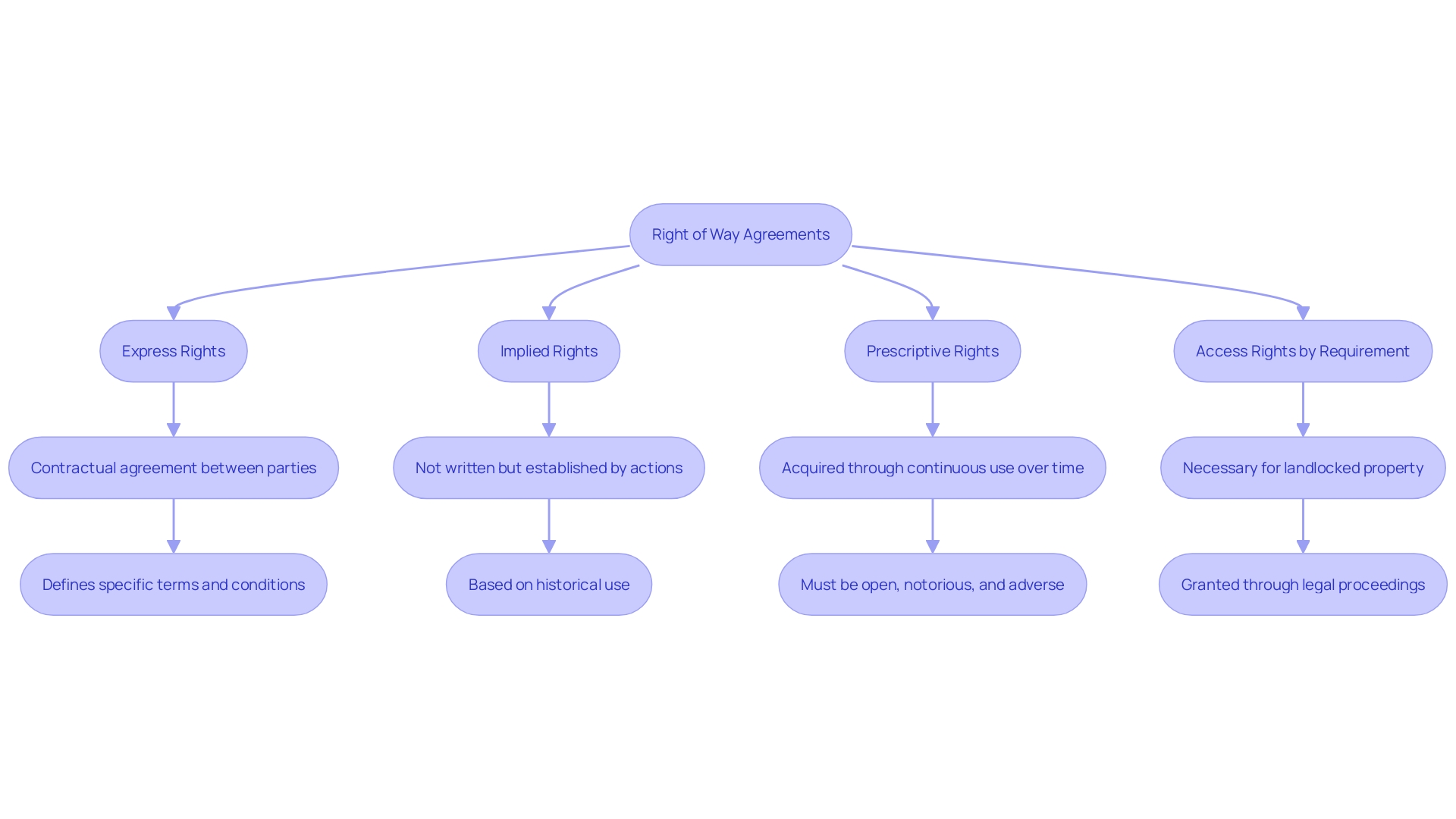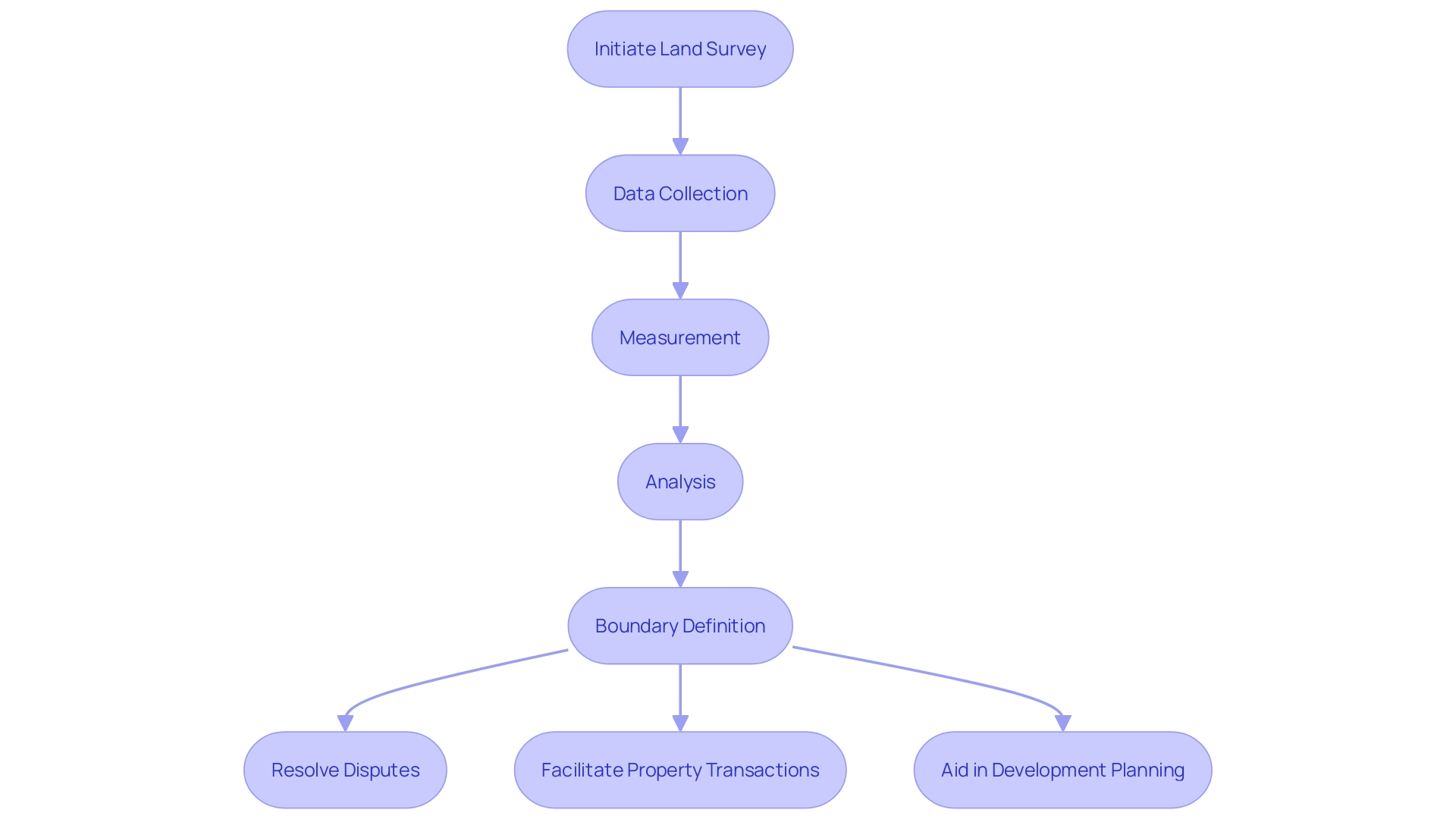Introduction
Landowners must have a clear understanding of right of way easements, as they can greatly impact property use and value. These legal agreements allow certain parties to use or traverse a portion of another's land for a specific purpose. There are different types of easements, including express, implied, prescriptive, and easements by necessity, each with its own set of characteristics and implications.
It is crucial for landowners to grasp these nuances in order to make informed decisions and effectively manage their properties. Additionally, recent events have highlighted the financial implications of land management decisions, further emphasizing the need for a comprehensive understanding of right of way easements. By arming themselves with this knowledge, landowners can confidently navigate property rights and strategically manage their land.
Types of Right of Way Easements
Landowners must have a sharp understanding of the intricacies in right of way agreements, as these legal contracts can greatly impact property use and value. Right of way agreements allow certain parties to traverse or use a portion of another's land for a specific purpose. Express rights are formed through written agreements and are explicitly given by the landowner. Implied rights of way, while not written, are inferred from the circumstances and actions of the parties involved. Prescriptive rights emerge from uninterrupted and public utilization of a parcel without the explicit consent of the owner over a legally designated duration. Finally, access rights by requirement are established when a landlocked parcel needs entry to a public road. Understanding these types can empower landowners to make informed decisions and manage their properties effectively.
A remarkable instance illustrating the intricacies encompassing these rights-of-way involved Scenic Nevada's opposition to a development agreement. The court's recognition of Scenic Nevada's standing reaffirmed the importance of adhering to existing agreements and underscored the potential legal ramifications of easement disputes.
Additionally, recent events have highlighted the financial implications of property management decisions. For instance, a City Council gathering unveiled that substantial amounts could be expended on legal disputes regarding ownership privileges, underscoring the necessity for precise comprehension and tactical preparation in acquisition and administration of real estate.
In summary, the complexities of the privilege of passage agreements are crucial for landowners to understand. From the legal standing in development agreements to the financial impact of real estate disputes, these easements play a central role in ownership and management strategies. Equipped with this understanding, landowners can navigate the landscape of ownership rights with assurance and accuracy.

Establishing Highway Boundaries and Property Lines
Comprehending the complexities of property boundaries is an essential element for landholders and road departments alike. Accuracy in defining the precise boundaries of highways and private assets is not only a legal obligation but also a practical imperative to prevent conflicts and ensure efficient management. For instance, the City of Plano, Texas, exemplifies the modern approach towards managing land-related challenges. They utilized Esri's ArcGIS technology to create a comprehensive inventory of over 81,000 service lines, mapping out the public and private domains with remarkable precision. Their efforts reflect the core of a survey, which includes carefully measuring and defining boundaries and topographic characteristics.
Land surveys, conducted by professional surveyors using advanced tools, play a crucial role in establishing these boundaries. They serve multiple purposes, such as resolving boundary disputes, facilitating property transactions, and aiding in development planning. In practice, surveys can uncover the exact measurements, tangible characteristics, and legal limits of a parcel. Moreover, they can significantly contribute to informed decision-making in use and infrastructure development, as evidenced by the city of Plano's initiative to meet stringent Lead and Copper Rule Revisions (LCRR) requirements.
In accordance with the stories conveyed by experienced real estate experts, the main reason for involving a surveyor is to precisely identify the boundaries, particularly during real estate transactions. This process is essential not only for individual homeowners but also for local governments, as they navigate budget constraints and maintain existing infrastructure. For example, FHWA's collaboration with state highway agencies and private contractors for data reporting is indicative of the importance of accurate data in managing and upgrading transportation networks.
These examples emphasize the significance of meticulous surveys of the terrain and the role of surveyors in safeguarding the privileges and interests of property owners, while also facilitating the efficient functioning of government departments in managing land and infrastructure.

Highways by Use: Understanding Public Highways
Public highways, encompassing state highways, county roads, and local streets, serve as the lifeblood of transportation infrastructure, connecting communities and facilitating commerce. Each type of public highway carries specific legal implications for landowners whose properties border these thoroughfares. For example, property owners must be conscious of the easements that may affect their property and the obligations they have towards the upkeep and availability of these public routes. The classification of public highways is not merely an administrative detail; it plays a crucial role in determining the extent of landowner obligations and the public's access rights.
The importance of understanding these classifications and regulations cannot be overstated, as demonstrated by the Safe System approach adopted in various U.S. communities. This approach emphasizes a multi-faceted, collaborative effort, as seen in Menlo Park, California, and West Hartford, Connecticut, to implement transportation systems that are sustainable and safe for all users. Such frameworks are essential for the continuous improvement of transportation infrastructure and highlight the need for landowners to stay informed and engaged with public highway developments.
Recent legislative changes, as noted in news updates, further underscore the intersection of terrain use and transportation planning. For instance, a project in Los Angeles experienced significant delays and property loss due to road widening requirements. This situation reflects the ongoing challenges and changes in public highway regulations that can directly affect landowners and community development.
In light of these evolving landscapes, it's crucial for landowners to understand the historical significance of public highways as platforms for expression and protest, as well as the economic implications highlighted by the Federal Reserve's emphasis on the role of modern transportation infrastructure in achieving price stability and maximum employment. The interplay between engineering and economics is a testament to the integral part that public highways play in our society.
Finally, the Federal Highway Administration's (FHWA) strategies for quality data collection, including partnerships with State highway agencies and private contractors, offer insight into the meticulous process behind maintaining and improving our public highways. Such data-driven initiatives are vital for the informed management and development of transportation infrastructure that aligns with the needs of landowners and the broader community.
Right of Way Acquisition and Legal Foundations
The acquisition of land for public use, also known as the right of way, is a nuanced legal process deeply rooted in the concept of eminent domain. Eminent domain allows the government to acquire private assets for public use, provided that certain criteria are met. These criteria, enshrined in the Fifth Amendment of the U.S. Constitution, include public use, just compensation, due process, and necessity. In essence, the term 'condemnation' associated with eminent domain does not reflect the nature of the real estate but signifies the legal mechanism for its acquisition.
The eminent domain process usually starts with a governmental entity offering to purchase the land. If denied, the government can turn to legal condemnation to acquire the possession, highlighting that ownership includes the privilege to prevent others from utilizing it. A 'privilege to pass' is a specific kind of ownership entitlement that permits the bearer to cross someone else's land, demonstrating this exclusive characteristic. Appraisals play a critical role in ensuring fair compensation, which is a cornerstone of just acquisitions.
Historical cases, such as the Bruce's Beach incident, where eminent domain was used to seize assets under contentious circumstances, underline the importance of due process and legality in the acquisition process. Legal professionals are essential in navigating the complexities of way laws, ensuring that landowners' are upheld. For example, grasping nuances like 'net mineral acres' mentioned in leases can affect compensation, as observed in the case of a family farm in Greene County, Pennsylvania.
Furthermore, with the evolving regulations on land use, like those emphasized in the recent Sheetz v. County of El Dorado case, the legal framework concerning ownership rights and urban expansion persists in questioning established models. In this ever-changing setting, keeping up-to-date through sources such as the Eminent Domain Podcast or legal blogs can offer valuable perspectives into the consequences of ownership, utilization, and eminent domain regulations.
Terminating a Right of Way Easement
Understanding the intricacies of terminating a pathway privilege is a vital element of property ownership. A right of way can come to an end under different circumstances, and comprehending these can empower landowners in effectively managing their property rights. One such condition is abandonment, where the land user ceases to use the property for an extended period, signaling a relinquishment of the legal right to use the land. Another situation is the end, as some permissions are granted for a specific period of time. Upon reaching the end date, the agreement naturally terminates without the need for further action.
Mutual agreement between the landowner and the right-of-way holder represents another path to dissolution. Both parties may decide that the right of way is no longer necessary or beneficial and formally agree to its termination. It's important to note that the termination process often requires a written agreement and, in some cases, a formal release of the rights of usage, which must be recorded with the appropriate governmental office to effectively remove the encumbrance from the property record.
Besides these approaches, legal disputes can occur, resulting in the end of a right of way. For example, if a right of way was acquired through coercion or without proper adherence to legal requirements, it may be challenged and ultimately extinguished. Recent cases emphasize the controversial character of such proceedings, where landowners have expended considerable resources defending their property against perceived overreach by others, including governmental entities.
For individuals impacted by encumbrances, it is crucial to remain knowledgeable about your entitlements and the procedures associated with encumbrance cessation. As referenced in the book 'Legal Foundations of a Free Society,' a right of way is not so much a right to control a resource but a right to exclude others from using that resource. Ending a legal restriction allows the landowner to regain complete authority over their property, without any of the obligations imposed by the previous arrangement. By understanding these principles and the proper procedures, landowners can navigate the complexities of easement termination with greater confidence and legal foresight.

Practical Considerations for Property Owners and Highway Departments
Property owners and highway departments must navigate the complexities of land entitlement laws with a strategic approach. For landowners, it is critical to assess how proposed road work could change access to the land. Employing a traffic engineer can provide valuable insights into the impact of such changes, especially considering customer access and on-site traffic patterns. It is also essential to understand whether government actions necessitate compensation for access modifications, a process that can be intricate and requires careful legal consideration.
Highway departments have an obligation to communicate effectively with landowners, addressing their concerns and striving to prevent disputes. This includes being transparent about the intentions and requirements of the project. For example, the Zoning Justice Project led by the Institute for Justice advocates for the liberty of land use and provides remedies to combat the undermining of land privileges by oppressive zoning policies.
Real-world cases, such as Orlando Capote's ongoing battle in Coral Gables to preserve his family home amidst major real estate development, highlight the personal stakes involved. Likewise, the general feeling expressed by participants at a City Council gathering demonstrates the significance of comprehending laws related to possession and entitlements to avoid excessive intervention by the government.
Understanding the distinction between legal requirements and recommendations in the Highway Code is crucial for both parties. 'Must' or 'must not' directives are mandates, while 'should' or 'should not' serve as guidelines that can influence legal outcomes if not followed. It is also important to acknowledge the diversity of laws applicable to different kinds of highways, ensuring compliance with each.
When contemplating ownership rights, it is imperative to take into consideration the 'ability to exclude' as a fundamental aspect, rather than solely focusing on the 'ability to control' resources, as this shapes the legal interpretation of a right of way.
The Federal Highway Administration (FHWA) has implemented strategies for quality data collection, which are vital for informed decision-making. These strategies include partnering with State highway agencies, involving private contractors, and direct data acquisition from private businesses, all of which contribute to a comprehensive understanding of national travel demand and facilitate transportation performance management.
To summarize, both owners of assets and highway departments can achieve mutually advantageous results by carefully examining the effect of road projects, comprehending the legal structure of land access, and upholding transparent, open channels of communication.
Federal and State Laws Governing Right of Way
Understanding both federal and state statutes that dictate use for development projects is necessary to navigate the complexities of right of way laws. At the federal level, legislation such as the Uniform Relocation Assistance and Real Property Acquisition Policies Act provides a framework for property acquisition and compensation for displaced individuals. Similarly, the National Environmental Policy Act ensures environmental considerations are factored into any usage decisions. These laws are crucial for maintaining compliance and facilitating successful land development endeavors.
State-specific laws also play a crucial role, particularly when road work or modifications alter access to a location. For instance, retail property owners facing access point adjustments due to road widening or bridge repair projects must be vigilant. The number, location, or size of curb cuts could be brought up to current codes, potentially impacting site layout and value. In such cases, the analysis of what is compensable can be challenging, as the government may deny compensation, citing the exercise of its police power.
Furthermore, impending infrastructure spending bills could introduce additional modifications to highway access, affecting retail sites. Property owners should proactively engage with such projects, possibly retaining traffic engineers to assess the impact of any changes. These situations highlight the significance of comprehending one's entitlements when encountering government actions that may result in land acquisition or alteration of access.
The Federal Energy Regulatory Commission (FERC) provides resources for landowners potentially affected by natural gas or hydroelectric projects. Details about entitlements and the administrative procedure can be accessed via manuals, blueprints of commission procedures, and FAQs. The Public Reference Room and Library serve as the Commission's main channels for distributing such vital information.
An upcoming webinar on May 21, 2024, will offer stakeholders the latest updates on these matters, emphasizing the importance of staying informed. Moreover, changes to the Uniform Act aim to minimize the adverse impacts of displacement by streamlining government processes and reducing administrative burdens. With the U.S. Department of Transportation as the lead agency for the Uniform Act, annual reports to Congress will provide transparency and oversight.
Retail property owners and other stakeholders must remain vigilant and informed to navigate the intricate legal landscape of access laws. Understanding these regulations and accessing available resources can help mitigate the impact of land use changes and ensure fair compensation when applicable.
Common Issues and Disputes in Right of Way Easements
Understanding the various potential issues that landowners may encounter is crucial when navigating the complexities of granting access to a property. Trespass, for example, can happen when unauthorized buildings or activities encroach on the restricted area, as observed in the situation of navigation rights near airports. An example is the dispute at Rocky Mountain Metro Airport, where residential developments encroached on protected airspace, leading to extended legal confrontations about increased noise and air traffic.
Maintenance responsibilities are another common source of contention. These must be precisely specified to prevent conflicts, similar to the legal dispute between Reeves LLC and Godspeed Properties LLC, where the Alaska Supreme Court determined that modifications to a privilege of way must correspond to its stated objectives and not unduly hinder the privileges of the privilege of way holder.
Unauthorized use of a right of way can also result in intricate legal complications. An illustrative scenario involves XYZ Drilling Company's lease agreement with a family in Greene County, Pennsylvania, which resulted in unexpected financial discrepancies due to unclear terms regarding ownership of minerals on the property.
To effectively resolve these disputes, it is crucial to engage in a multi-faceted approach that might include negotiation, mediation, or legal recourse, always aiming for an amicable resolution. Strategic positioning for a lawsuit or other action should be a last resort, considering the broad scope of litigation that encompasses all stages of a dispute and any type of dispute resolution process. The objective for landowners should be to proactively manage these easement issues, thereby safeguarding their rights and fostering harmonious relationships with users of the land.
Conclusion
In conclusion, understanding right of way easements is crucial for landowners to make informed decisions and effectively manage their properties. Recent events highlight the financial implications of land management decisions, emphasizing the need for a comprehensive understanding of easements. Landowners must grasp the intricacies of establishing boundaries, understanding public highways, and the nuances of acquisition and termination.
By staying informed and strategic, landowners can navigate property rights confidently. Compliance with federal and state laws is vital in land development. Common issues like encroachment and maintenance disputes can be resolved through negotiation and legal recourse.
In summary, a comprehensive understanding of right of way easements empowers landowners to navigate complexities with precision and make informed decisions for their properties.




